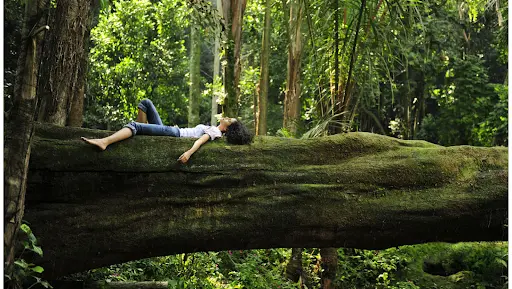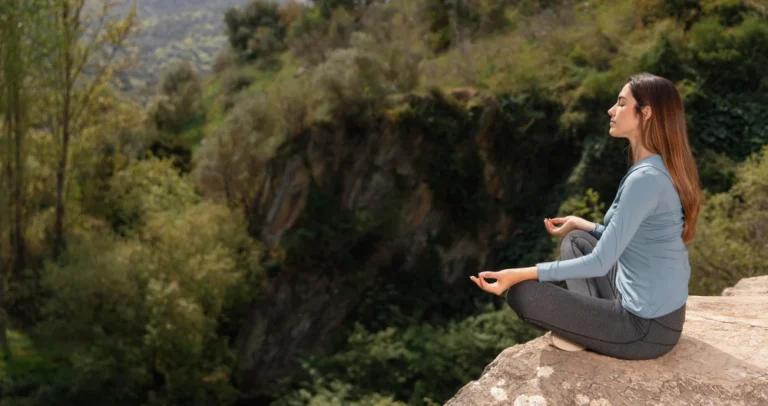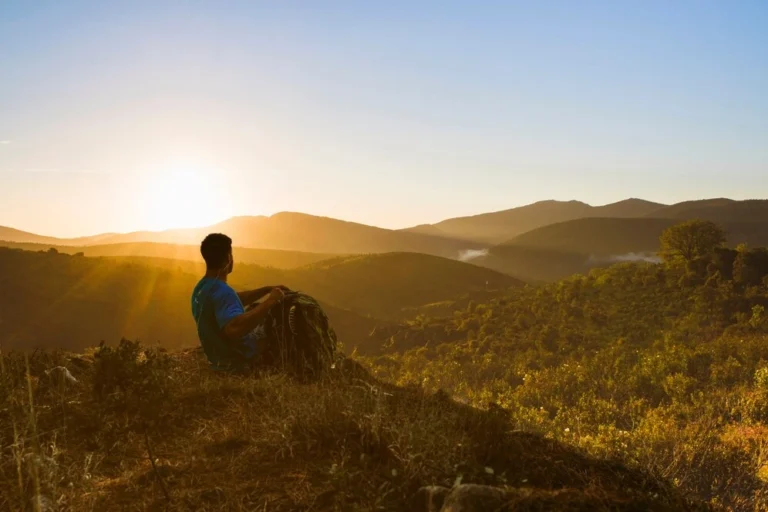
The Japanese call it “shinrin-yoku.” The Koreans know it as “sanlimyok.” In English, we’ve adopted the term “forest bathing.” Regardless of what you call it, the practice of immersing yourself in forest atmospheres has emerged as one of the most scientifically validated forms of nature therapy available today. Unlike hiking, which focuses on destination, or nature photography, which centers on documentation, forest bathing invites us to slow down and engage all our senses in the present moment beneath the canopy.
As our world grows increasingly digital and urban, the forest offers a powerful antidote a space where the sympathetic nervous system can finally power down, where the phytoncides (aromatic compounds) released by trees boost our immune function, and where the filtered green light naturally lowers blood pressure and stress hormones. The practice isn’t about exercise or covering distance; it’s about presence, sensory engagement, and allowing the forest to enter through your senses. Journey inward and outward with nature immersion trips
This guide explores the world’s most extraordinary forest bathing destinations places where the combination of tree species, forest structure, accessibility, and often cultural recognition creates optimal conditions for this healing practice. From ancient Japanese cedar groves to towering redwood cathedrals, these forests offer unique healing properties and experiences for the mindful visitor willing to disconnect from technology and connect deeply with the natural and earth.
The Science Behind Forest Healing: Why These Destinations Matter
Before exploring specific destinations, understanding the science behind forest healing helps explain why certain forests offer particularly potent therapeutic effects.
Research conducted primarily in Japan and South Korea has identified several key mechanisms through which forests improve human health:
Phytoncide Exposure
Trees release aromatic compounds called phytoncides as protection against insects and disease. When humans inhale these compounds, our bodies respond by increasing the activity of natural killer (NK) cells a type of white blood cell that helps fight cancer and infections. Studies have found that just three days of forest immersion can increase NK cell activity by up to 50%, with effects lasting for more than 30 days.
Different tree species produce different phytoncide profiles. Coniferous forests (pine, cedar, spruce) generally emit higher concentrations than broad-leaved forests, creating varying therapeutic atmospheres.
Fractal Patterns and Attention Restoration
Natural environments are rich in fractal patterns self-similar shapes that repeat at different scales. The human visual system evolved processing these patterns, requiring less cognitive effort than processing urban environments. This reduced mental fatigue explains why even visual exposure to forests helps restore directed attention, the finite cognitive resource that modern life rapidly depletes.
Forests with diverse understory plants, canopy layers, and tree species offer particularly rich fractal complexity, enhancing this restorative effect.
Negative Ion Concentration
Forests, especially those near moving water, contain significantly higher concentrations of negative air ions compared to urban environments. These ions have been associated with reduced depression symptoms, improved cognitive performance, and enhanced psychological well-being. Forest bathing destinations that combine forests with waterfalls, ocean proximity, or high altitude typically offer the highest negative ion concentrations.
Light Quality and Quantity
The filtered green light beneath a forest canopy has measurable effects on human physiology, including lower blood pressure and heart rate compared to urban light environments. Additionally, the reduced light intensity helps regulate circadian rhythms disrupted by artificial lighting and screen exposure.
Ancient forests with developed canopy layers create particularly beneficial light environments for human nervous system regulation.
Have you ever noticed how time seems to expand in a forest? How your breathing naturally deepens? These subjective experiences reflect measurable physiological shifts that occur when our bodies recognize forest environments as home—a reminder of the landscapes in which human physiology evolved.
Japanese Forest Therapy Sanctuaries: Where the Practice Was Born
Japan not only gave the world the concept of forest bathing but has developed the most sophisticated infrastructure for forest therapy internationally. The Japanese government has designated 62 official “Forest Therapy Bases” nationwide, where specific walking routes are medically studied and certified for health benefits.
Yakushima Island Ancient Cedar Forests
This UNESCO World Heritage site contains some of Japan’s oldest living trees, with some cedar specimens estimated to be over 7,000 years old. The “Wilson’s Stump,” a hollow cedar remnant large enough to stand inside, creates a cathedral-like space that forest therapy guides describe as having particularly powerful emotional effects.
The island’s unique ecosystem—where cedar forests meet subtropical vegetation in a perpetually moist environment creates exceptional air quality rich in terpenes and negative ions. Research conducted here shows particularly strong immune-boosting effects compared to younger forests.
Forest Bathing Experience: Yakushima’s Shiratani Unsuikyo Ravine offers gentle paths through moss-covered ancient cedars. The perpetual moisture creates a misty atmosphere that enhances both phytoncide concentration and the sensory immersion experience. Many visitors report profound shifts in time perception and heightened sensory awareness in these forests.
Akasawa Natural Recreational Forest
Recognized as the birthplace of modern forest therapy research, Akasawa contains 300-year-old cypress trees that produce exceptionally high concentrations of phytoncides. This forest became Japan’s first designated “forest therapy base” after pioneering research here in 1982 demonstrated the physiological benefits of forest immersion.
The forest features specific “therapy roads” where medical measurements have confirmed stress reduction effects. Visitors can actually view data showing average cortisol level reductions and heart rate variability improvements achieved on different trails.
Forest Bathing Experience: Guided sessions here often include physiological measurements before and after forest immersion, allowing participants to see their own stress reduction data. The cypress-dominated ecosystem creates a distinctive aromatic profile that research suggests has particularly strong effects on parasympathetic nervous system activation.
Okutama Tokyo Therapy Roads
Proving that effective forest therapy doesn’t require remote locations, the Okutama region just 90 minutes from Tokyo offers certified therapy roads accessible by public transportation. These mixed deciduous and coniferous forests demonstrate how even proximity to urban centers doesn’t diminish forest healing potential.
Forest Bathing Experience: This forest exemplifies the Japanese approach to forest therapy infrastructure, with rest stations positioned at scientifically determined intervals, benches placed for optimal viewing of fractal patterns, and signage that guides visitors through sensory activation exercises rather than simply providing information.
North American Ancient Forest Sanctuaries
North America’s forests offer extraordinary diversity, from the towering redwoods of California to the ancient Eastern deciduous woodlands. While formal forest therapy infrastructure lags behind Asia, several locations stand out for their exceptional healing qualities.
Redwood National and State Parks, California
Home to the world’s tallest trees, these forests create a uniquely powerful experience of scale and perspective. The coast redwood ecosystem generates distinctive air quality, with high humidity that enhances phytoncide dispersal. The extreme age of these trees (some exceeding 2,000 years) creates a palpable sense of time dilation that visitors consistently report as perspective-shifting.
Research indicates that the filtered light through redwood canopies has particularly strong effects on melatonin production and circadian rhythm regulation, addressing a core aspect of modern stress.
Forest Bathing Experience: Prairie Creek’s Revelation Trail was specifically designed for sensory engagement, with features like textured bark at wheelchair height and aromatic plants positioned for optimal olfactory experience. The Cathedral Trees area creates natural sound chambers where forest acoustics enhance the immersive experience.
Great Smoky Mountains National Park, Tennessee/North Carolina
Containing some of the world’s greatest temperate deciduous forest diversity, this ecosystem offers over 100 native tree species and a forest structure that has evolved over millions of years. Research here has identified particularly high negative ion concentrations owing to the abundant moving water and elevation changes.
Forest Bathing Experience: The old-growth sections around Albright Grove loop provide a multi-sensory immersion in a forest type that once covered much of eastern North America. The diverse understory plants create layered aromatic experiences that change dramatically with seasons. Spring visits offer the added benefit of negative ions from abundant rainfall and flowing streams.
Olympic National Park’s Hoh Rainforest, Washington
One of America’s few temperate rainforests, this moss-draped ecosystem receives up to 14 feet of rain annually, creating extraordinary air quality and soundscapes. The combination of old-growth conifers and perpetual moisture creates ideal conditions for phytoncide dispersion and negative ion generation.
Studies measuring air quality here have found some of the cleanest air documented in the United States, providing a respiratory experience increasingly rare in the modern world.
Forest Bathing Experience: The Hall of Mosses trail offers gentle immersion in an environment where sound behaves differently due to the acoustic properties of moss. The muffled soundscape naturally induces the kind of quiet mind state that meditation practices seek to create. Many forest therapy guides consider this location ideal for first-time forest bathers due to its immediate sensory impact.
European Ancient Woodlands: Cultural Heritage Meets Forest Therapy
Europe’s forests carry millennia of cultural history alongside their ecological significance, creating unique forest bathing experiences that connect visitors to both natural and human heritage.
Białowieża Forest, Poland/Belarus
As Europe’s largest remaining primeval forest, Białowieża contains trees up to 450 years old and ecosystem processes largely unchanged for thousands of years. This UNESCO World Heritage site provides a rare opportunity to experience a European lowland forest as it existed before intensive human modification.
The forest’s extraordinary biodiversity—including 20,000 species and Europe’s largest land mammal, the European bison—creates complex biotic interactions that generate distinctive airborne compounds beyond what simplifed forests produce.
Forest Bathing Experience: The strictly protected sections accessible only with guides offer an increasingly rare experience of rewilding—what forests become when human intervention ceases. Visitors consistently report profound emotional responses to witnessing relationships between species that have co-evolved for millennia.
The Black Forest, Germany
Beyond its fairy tale associations, Germany’s Black Forest offers extensive silver fir and Norway spruce stands that create distinctive terpene profiles with documented stress-reduction properties. The region has embraced forest therapy through the development of “Kneipp therapy” paths that combine forest immersion with hydrotherapy.
Forest Bathing Experience: The cultural integration of forest wellness in this region creates unique offerings like forest spas, where traditional European hydrotherapy meets Japanese forest bathing principles. The contrast between dense evergreen stands and open meadows creates natural “breathing rooms” that forest therapy guides use to enhance parasympathetic nervous system engagement.
The New Forest, England
Despite its name, this forest contains trees dating back to medieval times within a cultural landscape managed through traditional commoning practices for over 900 years. The resulting wood pasture ecosystem—a mosaic of ancient trees and open space—creates distinctive light patterns particularly effective for attention restoration.
Forest Bathing Experience: The presence of free-roaming ponies and cattle creates unique multi-species encounters rarely found in more strictly protected forests. Research suggests that these animal-human-forest interactions activate different neural pathways than plant-only environments, potentially enhancing the therapeutic effect through increased varieties of attention.
Oceania’s Living Museums: Southern Hemisphere Forest Immersion
The isolated evolution of Southern Hemisphere forests has produced tree species and forest structures found nowhere else on Earth, creating distinctive forest bathing environments.
Waipoua Forest, New Zealand
Home to Tāne Mahuta, the largest kauri tree in the world, this forest preserves an ancient Gondwanan ecosystem dominated by trees that have remained relatively unchanged for millions of years. The distinctive properties of kauri resin create a unique forest atmosphere.
The cultural significance of these forests in Māori tradition adds a layer of meaning to forest bathing experiences here, with ancient trees recognized as ancestors and living entities with their own mauri (life force).
Forest Bathing Experience: Guided forest bathing with Māori practitioners offers insight into Indigenous relationships with forests that predate formal shinrin-yoku by thousands of years. These experiences often incorporate traditional practices that recognize forests as communities of beings rather than collections of resources.
Daintree Rainforest, Australia
As the world’s oldest continuous tropical rainforest (dating back 180 million years), the Daintree offers immersion in evolutionary time. The extraordinary biodiversity—with plant lineages from ancient Gondwana—creates complex aromatic compounds found nowhere else on Earth.
Forest Bathing Experience: The combination of ancient forest and nearby Great Barrier Reef creates unique opportunities for comparative immersion in Earth’s oldest ecosystem types. Forest therapy programs here often alternate between forest and reef immersion, highlighting the physiological similarities in how human bodies respond to these complex natural environments.
African Forest Wisdom: Ancient Connection Practices
While less developed in formal forest therapy infrastructure, African forests preserve some of humanity’s oldest traditions of nature connection.
Kakamega Forest, Kenya
As East Africa’s only remnant of the ancient Guineo-Congolian rainforest, Kakamega preserves ecosystem processes that human ancestors evolved alongside. The forest contains over 380 documented medicinal plant species used in traditional practices that recognize the connection between human and forest health.
Forest Bathing Experience: Programs led by local guides often incorporate elements of traditional ecological knowledge that predates modern science but reaches similar conclusions about forest benefits. These experiences bridge Indigenous wisdom and contemporary forest therapy practices, creating culturally rich immersion experiences.
The Knysna Forest, South Africa
This Afromontane forest featured in Dalene Matthee’s novels contains ancient yellowwood trees over 600 years old within a forest ecosystem that stretches back thousands of years. The forest’s famous elephants create unique ecological dynamics rarely experienced in forest therapy settings elsewhere.
Forest Bathing Experience: The complex cultural history of these forests—from Indigenous Khoi-San uses to modern conservation efforts—provides unique opportunities for exploring human-forest relationships across time. Forest therapy here often incorporates storytelling elements that help visitors process their own forest experiences.
Mindful Engagement: Practices for Deepening Forest Connection
Regardless of which forest destination you choose, certain practices enhance the therapeutic benefits of forest immersion:
The Invitation Walk
Developed by the Association of Nature and Forest Therapy, this foundational practice helps transition from “doing” to “being” mode:
- Find an entrance to the forest—physical or symbolic
- Pause to set an intention for your forest time
- Cross this threshold slowly, consciously choosing to leave behind technological distractions
- For the first 15-20 minutes, walk no more than 400 meters, moving at “half the speed you think you should”
- Notice what draws your attention or “invites” you to engage
This deceptively simple practice helps reset attention patterns from goal-oriented focus to open awareness, activating the default mode network associated with creativity and perspective-taking.
The Sit Spot Practice
Common across nature connection traditions worldwide:
- Find a place in the forest that calls to you
- Sit there for at least 20 minutes (45-60 minutes creates deeper shifts)
- Remain in one place while expanding awareness outward
- Return to this same spot repeatedly during your stay or across seasons
Research shows that this repeated, place-based connection activates different neural networks than constant novelty-seeking, creating the conditions for insight and pattern recognition.
Sensory Expansion
Particularly powerful in phytoncide-rich environments:
- Systematically move through your senses: sight, sound, touch, smell (and where appropriate, taste)
- For each sense, first notice what’s most obvious, then expand to subtler perceptions
- Try temporarily closing the dominant sense (often vision) to heighten others
- Practice “deer ears” by cupping hands behind ears to amplify forest sounds
- Try “owl vision” by softening gaze to take in peripheral motion
This practice helps overcome the sensory dulling common in technologically mediated environments, restoring perceptual capacities often dormant in daily life.
Common Concerns & Solutions for Forest Bathing Travel
“I’m not sure I’m ‘doing it right’ or getting the benefits.”
Solution: Unlike many wellness practices, forest bathing resists standardization and quantification. The primary indicator is subjective experience: do you feel different after forest time? Research shows that intentional forest immersion works through multiple pathways, many below conscious awareness. Physical measurements consistently demonstrate stress reduction effects even when participants don’t subjectively feel different. Trust the process and your body’s innate response to forest environments.
“I don’t have access to pristine ancient forests.”
Solution: While old-growth forests offer certain unique qualities, research confirms that even urban parks provide measurable health benefits. The key factors are tree canopy coverage, relative quiet, and time spent. Three hours in a local woodland offers more benefit than a rushed visit to a pristine but distant forest. The best forest for healing is one you can access regularly. Many practitioners recommend combining occasional immersion in exceptional forests with regular connection to accessible local nature.
“I’m concerned about safety in remote forest areas.”
Solution: Valid concerns about unfamiliar environments shouldn’t prevent forest connection. Consider: guided experiences with certified forest therapy guides who prioritize safety; forest therapy trails in national parks with established infrastructure; forest bathing programs at botanical gardens and arboretums that offer controlled environments; or “forest therapy centers” in Japan, Korea and increasingly elsewhere that specifically design for safety and accessibility. Many locations now offer wheelchair-accessible forest therapy trails that balance immersion with security.
“I don’t have multiple days for forest immersion.”
Solution: While research shows dose-dependent relationships between forest time and benefits (with three days showing optimal immune responses), even brief experiences produce measurable effects. A Finnish study found significant stress reduction after just 15 minutes of seated forest rest. Quality often matters more than quantity—fully engaged presence for an hour likely provides more benefit than distracted presence for a day. Consider the Japanese practice of “forest air” time: deliberately breathing forest air for even brief periods throughout the day.
Before You Go: The Forest Bathing Preparation Checklist
Essential Preparations:
- Research forest bathing opportunities at your destination (guided experiences, established therapy trails, areas of old growth)
- Pack appropriate clothing for sitting on forest ground (moisture-resistant layer)
- Bring a small sit pad or lightweight portable stool for extended forest sitting
- Consider a journal dedicated to forest experiences and insights
- Research local tree species to deepen your connection through recognition
- Learn about any cultural significance of forests in your destination
- Check seasonal conditions (certain forests offer peak experiences in specific seasons)
- Prepare for technology disconnection with advance notifications to others
- Consider a field guide to local bird calls to enhance auditory recognition
- Pack non-wildlife-attracting snacks for extended forest sessions
- Bring appropriate tick/insect protection relevant to your destination
- Research local forest etiquette and access protocols (particularly important for Indigenous-managed forests)
Digital Minimalism for Forest Immersion:
If complete disconnection isn’t possible or advisable for safety reasons:
- Set devices to airplane mode to avoid disruptions while preserving emergency capacity
- Remove notification sounds and vibrations completely
- Pre-download any essential maps for offline access
- Consider a dedicated “forest camera” separate from your phone if documentation is important
- Establish specific times for device checks rather than constant availability
- Use voice memo features rather than typing for any necessary documentation
- Consider a basic digital camera that lacks connectivity if visual recording matters to you
Integrating Forest Wisdom: Bringing the Healing Home
While destination forest bathing creates powerful experiences, integrating forest connection into regular life multiplies the benefits:
Create Indoor Forest Microclimates
Research confirms that even indoor exposure to forest elements provides measurable benefits:
- Essential oils from forest species (particularly hinoki cypress and cedar) produce similar immune responses to forest exposure
- Indoor plants improve air quality and provide fractional exposure to beneficial plant compounds
- Wood elements in home environments reduce sympathetic nervous system activation compared to synthetic materials
- Recordings of forest soundscapes demonstrate measurable stress-reduction effects
Develop Micro-forest Bathing Practices
Even in urban environments, intentional connection practices enhance well-being:
- Identify a “backyard sit spot” for regular brief immersion
- Practice “street tree appreciation” during daily commutes
- Create seasonal awareness of changes in available tree species
- Develop “tree relationships” with specific individuals you visit regularly
Transformative Forest Souvenirs
Rather than conventional souvenirs, consider bringing home:
- A journal of sensory observations specific to each forest visited
- A small collection of ethically gathered fallen forest materials (where permitted)
- Audio recordings of specific forest soundscapes
- Knowledge of specific tree species encountered and their properties
- Forest therapy practices learned from local practitioners
Schedule Your Next Forest Immersion
Research shows that anticipation of forest experiences provides measurable well-being benefits. Before leaving one forest immersion, schedule your next—whether a major destination forest or a local woodland. This creates not only something to look forward to but an ongoing relationship with forest healing.
The Deeper Invitation: Forests as Teachers
Beyond their biochemical and psychological benefits, forests offer profound teachings particularly relevant to our modern challenges:
Lessons in Interconnection
Modern forest ecology has revealed that forests function not as collections of individual trees but as superorganisms connected through underground fungal networks that share resources and information. In forests, the concept of a wholly independent organism dissolves, offering powerful metaphors for human interdependence.
When we forest bathe with this awareness, we’re not simply visiting a collection of separate trees; we’re temporarily participating in an ancient communication system that operates on radically different principles than human society.
Perspectives on Time
In forests containing trees that germinated before the Roman Empire, industrial revolution, or digital age, we encounter a living timescape that contextualizes human concerns. Studies show that exposure to such “deep time” perspectives measurably reduces anxiety about transient problems.
Forest time—operating on scales from fungal networks that respond in seconds to trees that live millennia—offers a corrective to the digital acceleration that drives much modern stress.
Models of Regeneration
Forests demonstrate that disturbance and challenge often precede periods of extraordinary growth and diversity. The forest succession visible after fires, storms, or human impact provides living examples of resilience principles increasingly important in our volatile world. For travelers recovering from personal challenges, career transitions, or health crises, forests offer not just biochemical support but mental models for their own regeneration processes. A path to healing begins with nature-based travel.
As you contemplate your own forest bathing journey, consider that you’re not simply visiting these extraordinary places you’re being welcomed back into relationship with the ecosystems that shaped human physiology, cognition, and emotion over millions of years of evolution. The increasingly robust science of forest therapy simply confirms what traditional cultures worldwide have recognized: we belong among trees.
The forest awaits not as a backdrop for activities or a resource to utilize, but as a community of beings with profound gifts for those willing to slow down, pay attention, and remember their place in the family of things.






